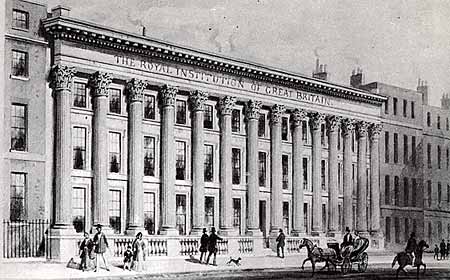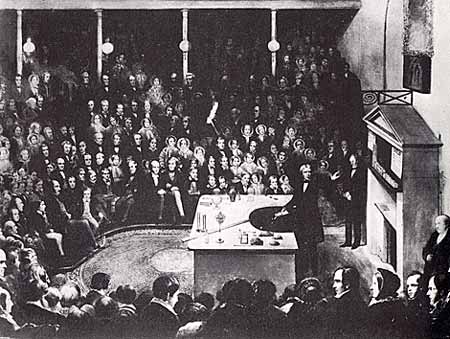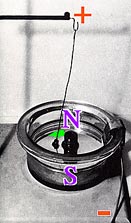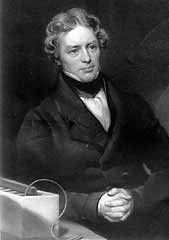![]()
![]()
The Royal Society is the world's oldest scientific academy in continuous existence, having been founded in 1660. The Society is a fellowship of the most eminent scientists of the day, elected by peer review for life. The Society is where scientist like Edmond Halley and Isaac Newton met and exchanged ideas. The Society is independent of government, as it has been throughout its existence, by virtue of its Royal Charters. In 1663, The Royal Society of London for the Improvement of Natural Knowledge was granted its Arms and adopted the motto Nullius in verba, an expression of its enduring commitment to empirical evidence as the basis of knowledge about the natural world.
The Royal Institution of Great Britain was formed nearly 140 years later under the auspices of Count Rumford with Humphry Davy as laboratory director and lecturer's assistant. It has been at the center of scientific research and the popularization of science for over 200 years with lecture series featuring experimental demonstrations. Indeed so popular were the lectures of Davy that those coming to the lectures made Albemarle Street so crowded that it was made the first one way street in London. Michael Faraday (1791 - 1867) was hired in the Spring of 1813 as an assistant to Davy, eventually replacing Davy upon Davy's retirement. Faraday founded the Friday Evening Discourses and the Christmas Lectures for young people in the mid-1820s. The latter have been televised since 1966.
 |
 |
 In 1821, with the discovery of the connection between electricity and magnetism the year before, the editor of the British journal Annals of Philosophy asked Faraday to write a review of experiments and theories of electricity and magnetism. Repeating Oersted's experiment, Faraday was impressed with the circular lines of force surrounding the current carrying wire. This led Faraday to speculate that circular lines of force could be used to create rotating motion. He designed an arrangement (shown at left) with a flexible vertical wire free to circulate about a central magnet in a puddle of mercury which it did clockwise when electric current flowed from + to –. This was the first, if primitive, electric motor.
In 1821, with the discovery of the connection between electricity and magnetism the year before, the editor of the British journal Annals of Philosophy asked Faraday to write a review of experiments and theories of electricity and magnetism. Repeating Oersted's experiment, Faraday was impressed with the circular lines of force surrounding the current carrying wire. This led Faraday to speculate that circular lines of force could be used to create rotating motion. He designed an arrangement (shown at left) with a flexible vertical wire free to circulate about a central magnet in a puddle of mercury which it did clockwise when electric current flowed from + to –. This was the first, if primitive, electric motor.
Many people who understood the symmetry in Newton's third law realized that if electric current could create circular motion, circular motion should somehow be capable of pushing on electric charges creating electric current. Faraday wrote that he had hoped to discover analogies between static electricity and the behavior of electric currents. Static electricity of one charge (say +) was known to induce in neighboring objects the opposite charge (- in that case). But the assumption that current in one coil of wire would cause an opposite current in a neighboring coil proved false.
 But the expected discovery eluded inventors until 1831. A mathematics teacher in Albany, New York, Joseph Henry, was the first to make the expected discovery. But his failure to publish for over a year allowed Faraday to independently make the discovery, thoroughly investigate all aspects and first explain it to the world. While Faraday had found no effects with steady current in a wire, he noticed that when current passing through wire wrapped around one side of an iron ring was turned on or off, current momentarily flowed through a second wire wrapped around the other side of the ring. Understanding that a current was induced in the second wire coil only when current was varied in the first wire coil, Faraday found that a magnet moving in and out of a wire coil would generate an electric current in the coil. This was the first electric generator and provided the theory for all modern generators which make our electric age possible.
But the expected discovery eluded inventors until 1831. A mathematics teacher in Albany, New York, Joseph Henry, was the first to make the expected discovery. But his failure to publish for over a year allowed Faraday to independently make the discovery, thoroughly investigate all aspects and first explain it to the world. While Faraday had found no effects with steady current in a wire, he noticed that when current passing through wire wrapped around one side of an iron ring was turned on or off, current momentarily flowed through a second wire wrapped around the other side of the ring. Understanding that a current was induced in the second wire coil only when current was varied in the first wire coil, Faraday found that a magnet moving in and out of a wire coil would generate an electric current in the coil. This was the first electric generator and provided the theory for all modern generators which make our electric age possible.
From the very beginning Faraday (shown at left) saw that in all cases the induction of an electric current depends on the relative motion of the circuit and the magnetic lines of force. Faraday found that the amount of induced current is proportional whether the wire moves directly or obliquely across the lines of force, in one direction or another, it sums up the amount of forces represented by the lines it has crossed
so that the quantity of electricity thrown into a current is directly as the number of curves intersected.
That is, the electromotive force is proportional to the number of lines of magnetic force crossed by the wire per second.
Record your observations recorded in your journal. If you need course credit, use the information in your journal to construct a formal report.
![]()
to next Experiment
to ie-Physics menu
to site menu